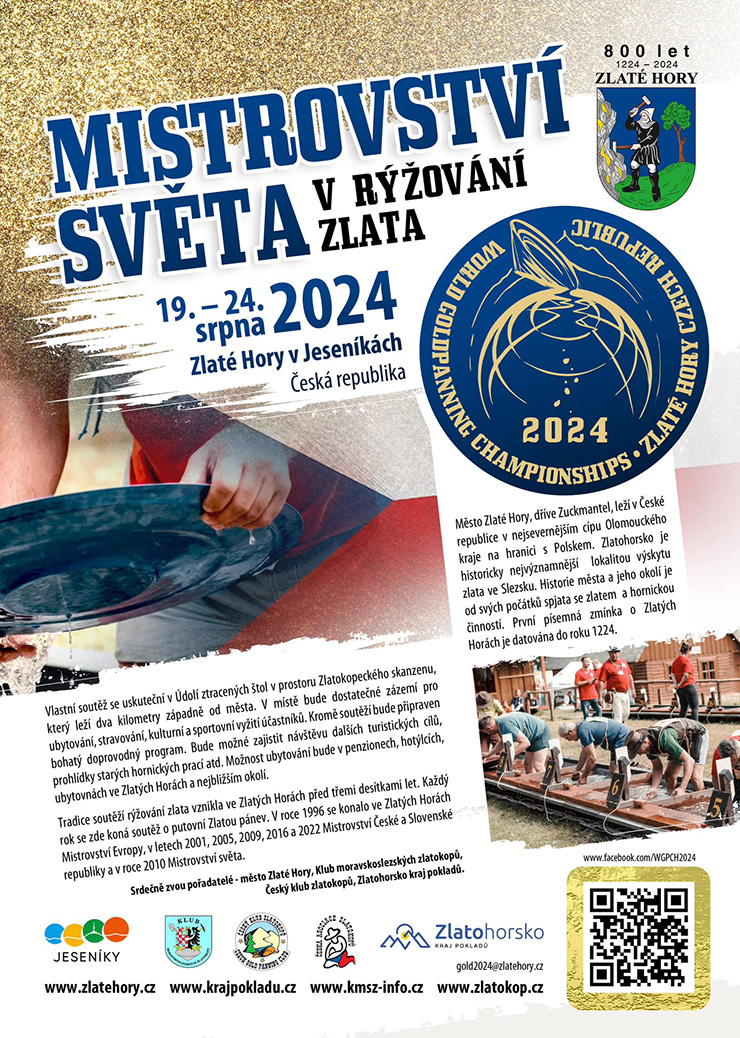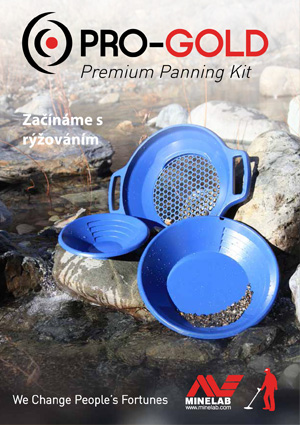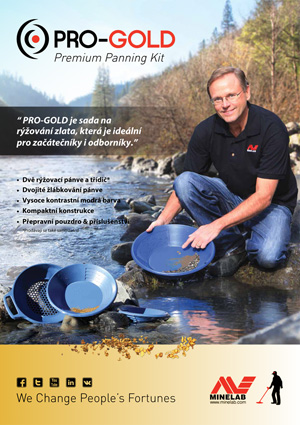Nechcu rýpat ale nadpis článku příliš nekoresponduje s jeho obsahem. Měl by se jimenovat spíš " Jak se rýžuje zlato". Pokud dáte do nadpisu název akce slušelo by se uvést aspoň základní údaje. Datum a místo je skutečně velmi málo.
World Gold Panning Championships 2024
Categories: Invitations , Search instructions
19 - 24 August 2024 Golden Mountains in Jeseníky
We invite you to the prestigious World Gold Prospecting Championships, which this year will take place in the picturesque surroundings of the Valley of Lost Adits, right in the area of the Gold Mining Open Air Museum. This historic site is located just two kilometres west of the town of Zlaté Hory.
Zlatokopecký skanzen On dřejovice 281, Zlaté Hory
Come and enjoy a unique experience and witness a thrilling race where the best gold miners from all over the world compete for the title of world champion.

How do you work with panning pans?
Click on the image to download both the instructions and the pan catalogue.
HOW TO PAN FOR GOLD
Before you start your first attempt at panning for gold, it is important to choose the right location. Choose a spot where the water is at least 15 centimetres deep and where the water current washes away any turbid water that might obstruct your view into the pan. Also find a comfortable place where you can sit down.
A. WASHING OUT LARGER STONES AND DEBRIS
Fill the pan about three-quarters full with gold-bearing material and submerge it in water just below the surface. Shake the material thoroughly in the pan several times in a horizontal front-to-back and side-to-side motion. Be careful not to let the material fall out of the pan.
When you have shaken the material sufficiently, start with a gentle circular motion so that the material in the pan begins to rotate around the perimeter. This movement will allow most of the dirt and clay to dissolve and wash out. Gently grind roots and larger clumps of clay with your fingers over the pan, and rinse larger stones over the pan and remove.
Repeat this process until the smaller gravel reaches the surface of the material and the heavier components begin to concentrate at the bottom of the pan.
B. WASHING OUT THE SAND AND SMALLER GRAVEL
Hold the pan just below the surface of the water and tilt it slightly away from you. Gently swirl the water in the pan from side to side, gently shaking the material to the sloping edge. Gently wash the surface layer of material and light grit over the edge of the pan.
From time to time, level the pan and shake the material to bring the lighter parts back to the surface and allow the gold to settle to the bottom.
Repeat this process until you only have about 2 cups of material left in the pan. This material is called concentrate.
C. WASHING THE CONCENTRATE
For beginners, it is best to remove the pan completely from the water and leave about a finger of water in it. Tilt the pan slightly toward you and spread the material around the perimeter in a circular motion so that you can easily spot any nuggets and pieces of gold and remove them easily.
Then submerge the pan in the water again and repeat the procedure from step B. This is a crucial part of the whole panning process, so work very carefully to ensure that the gold doesn't wash out. If you have a plastic pan, you can use a magnet to quickly separate the heavier magnetic component and the gold in the concentrate.
Place the magnet on the underside of the slightly tilted pan and move it in small circles to quickly separate the gold from the other materials.
GOOD ADVICE FOR PANNING
Before using a steel pan, thoroughly remove any residual grease by searing the pan over a fire. Heat it red hot first and then cool it quickly in water. This procedure not only removes the grease, but also gives the pan a deep blue hue on which the gold is more visible.
To speed up the final panning stage, keep a small bottle of detergent handy. A few drops added to the pan will reduce the surface tension of the water and make it easier to separate the gold.
Don't be discouraged. Our rivers and streams still contain gold that is recovered each year after winter storms. All you have to do is find it.
The article is included in categories:
- Archive of articles > Invitations
- Archive of articles > Tutorials and History Hunters Magazine > Search instructions
Post
dr.sysel: Ještě to doplníme (informace k akci) .)
Jj, kolem Zlatých hor, je tak trochu zapomenutý kraj bez davů turistů ( s výjimkou Rejvízu) a trochu zviditelnění a propagace si určitě zaslouží. 👍
Jasně že ano :) Mimochodem na Rejvíz jsem jezdili ještě když byl zapomenutý i on :) Místo je to nádherné :)
Právě proto, že je zapomenutý a odstrčený je tam zatím krásně. Ten konec světa je moje srdcovka. A nálezy odsuď mají pro mě úplně jinou "hodnotu". Propagaci ano, ale nájezdy turistů raději nikdy.
...nikdo nechce turisty :) Roky jsme jezdili do Orliček, Suchý vrch a okolí. Byly doby, kdy jsi šel po hřebenu až do Bartošovic a nepotkal jsi jediného člověka. Prostě duševní lázně. V covidu to tam ale objevili :) Nevím jak teď, letos se tam po dvouleté pauze chystáme, jezdil jsme tam celý život. Tak uvidíme :)









